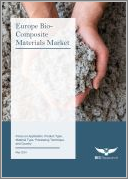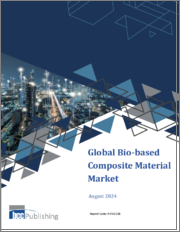
|
시장보고서
상품코드
1481276
유럽의 바이오 복합재료 시장 : 용도, 제품 유형, 재료 유형, 가공 기술, 국가별 분석과 예측(2023-2032년)Europe Bio-Composite Materials Market: Focus on Application, Product Type, Material Type, Processing Technique, and Country - Analysis and Forecast, 2023-2032 |
||||||
영국을 제외한 유럽의 바이오 복합재료 시장 규모는 2023년 18억 9,300만 달러에서 예측 기간 중 14.79%의 CAGR로 추이하며, 2032년에는 65억 4,860만 달러에 달할 것으로 예측되고 있습니다.
바이오 복합재료 시장의 성장은 자동차, 건설, 포장, 소비재 등의 다양한 분야에서 지속가능하고 분해 가능한 재료에 대한 인식과 이용이 높아지고 있는 것 등 복합적 요인에 의해 촉진될 것으로 예상되고 있습니다.
| 주요 시장 통계 | |
|---|---|
| 예측 기간 | 2023-2032년 |
| 2023년 평가 | 18억 9,300만 달러 |
| 2032년 예측 | 65억 4,860만 달러 |
| CAGR | 14.79% |
유럽의 바이오 복합재료 시장은 여러 가지 요인으로 인해 상당한 성장세를 보이고 있습니다. 우선, 환경 인식이 높아지고 지속가능한 관행을 장려하는 엄격한 규제가 이 지역의 다양한 산업에서 바이오 및 생분해성 재료의 채택을 촉진하고 있습니다. 자동차 산업은 가볍고 친환경적인 부품을 위해 바이오 복합재료를 채택하고 있으며, 건설 산업은 지속가능한 건축 솔루션을 위해 이러한 재료를 채택하고 있습니다. 포장 및 소비재 분야에서는 탄소 배출량을 줄이고 제품의 지속가능성을 높이는 바이오 복합소재의 이점을 인식하고 있습니다. 정부 구상과 지원 정책도 시장 확대를 더욱 촉진하고 R&D를 장려하며 바이오 복합재 기술 혁신을 촉진하고 있습니다. 지속가능한 구상의 최전선에 있는 유럽에서 바이오 복합재 시장은 환경 문제를 해결하고 진화하는 소비자 취향에 부응하고자 하는 제조업체와 이해관계자들에게 유리한 기회를 제공합니다.
시장의 분류
세분화 1 : 용도별
- 자동차
- 건설
- 항공우주
- 소비재
- 포장
- 일렉트로닉스
- 재생에너지
- 기타
세분화 2 : 재료 유형별
- 천연섬유
- 목질 섬유
- 바이오폴리머
- 차세대 재료
- 재활용 재료
- 합성 폴리머
- 기타
세분화 3 : 제품 유형별
- 그린 복합재료
- 하이브리드 복합재료
세분화 4 : 가공 기술별
- 압축성형
- 사출성형
- 수지 트랜스퍼 성형
- 압출성형
- 기타
세분화 5 : 국가별
- 독일
- 프랑스
- 이탈리아
- 스페인
- 기타
유럽의 바이오 복합재료 시장을 조사했으며, 업계의 동향, 시장 성장 촉진요인·억제요인, 시장 규모의 추이·예측, 각종 부문별 상세 분석, 경쟁 구도, 주요 기업의 개요 등을 정리하여 전해드립니다.
목차
주요 요약
조사 범위
제1장 시장
- 업계 전망
- 동향 : 현재와 향후
- 공급망 분석
- 바이오 복합재료와 기존 복합재료의 비교 분석
- 바이오 복합재료를 위한 새로운 바이오매스 자원
- 사업 역학
- 사업 촉진요인
- 사업상의 제약
- 사업 전략
- 기업 전략
- 사업 기회
제2장 지역
- 유럽
- 시장
- 용도별
- 제품별
- 국가별
- 영국
- 시장
- 용도별
- 제품별
제3장 시장 : 경쟁 벤치마킹·기업 개요
- 경쟁 벤치마킹
- 경쟁 포지션 매트릭스
- 기업 개요
- Bcomp Ltd.
- Meshlin Composites Zrt.
- Tecnaro GmbH
- UPM
제4장 조사 방법
KSA 24.05.24Introduction to Europe Bio-Composite Materials Market
The Europe bio-composite materials market (excluding U.K.) was valued at $1,893.0 million in 2023, and it is expected to grow at a CAGR of 14.79% and reach $6,548.6 million by 2032. The growth in the bio-composite materials market is expected to be driven by a combination of factors, predominantly propelled by increasing recognition and utilization of environmentally sustainable and decomposable materials across diverse sectors like automotive, construction, packaging, and consumer goods, among others.
| KEY MARKET STATISTICS | |
|---|---|
| Forecast Period | 2023 - 2032 |
| 2023 Evaluation | $1,893.0 Million |
| 2032 Forecast | $6,548.6 Million |
| CAGR | 14.79% |
Market Introduction
The Europe bio-composite materials market is witnessing substantial growth driven by a convergence of factors. Increasing environmental consciousness and stringent regulations promoting sustainable practices are fostering the adoption of bio-based and biodegradable materials across various industries in the region. The automotive sector is embracing bio-composites for lightweight and eco-friendly components, while the construction industry is incorporating these materials for sustainable building solutions. Additionally, the packaging and consumer goods sectors are recognizing the benefits of bio-composites in reducing carbon footprint and enhancing product sustainability. Government initiatives and supportive policies further bolster market expansion, encouraging research and development efforts and fostering innovation in bio-composite technologies. With Europe at the forefront of sustainable initiatives, the bio-composite materials market presents lucrative opportunities for manufacturers and stakeholders aiming to address environmental concerns and meet evolving consumer preferences.
Market Segmentation:
Segmentation 1: by Application
- Automotive
- Construction
- Aerospace
- Consumer Goods
- Packaging
- Electronics
- Renewable Energy
- Others
Segmentation 2: by Material Type
- Natural Fibers
- Wood Fibers
- Bio-Polymers
- Next-Generation Materials
- Recycled Materials
- Synthetic Polymers
- Others
Segmentation 3: by Product Type
- Green Composites
- Hybrid Composites
Segmentation 4: by Processing Technique
- Compression Molding
- Injection Molding
- Resin Transfer Molding
- Extrusion
- Others
Segmentation 5: by Country
- Germany
- France
- Italy
- Spain
- Rest-of-Europe
How can this report add value to an organization?
Product/Innovation Strategy: The product segment helps the reader to understand the different types involved in the bio-composite materials market. Moreover, the study provides the reader with a detailed understanding of the bio-composite materials market based on the application (automotive, construction, aerospace, consumer goods, packaging, electronics, renewable energy, and others). The bio-composite materials market is gaining traction in applications on the back of sustainability concerns and their higher tensile strength and toughness, among others. Bio-composite materials are also being used for controlling greenhouse gas (GHG) emissions. Moreover, partnerships and collaborations are expected to play a crucial role in strengthening market position over the coming years, with the companies focusing on bolstering their technological capabilities and gaining a dominant market share in the bio-composite materials industry.
Growth/Marketing Strategy: The Europe bio-composite materials market has been growing at a rapid pace. The market offers enormous opportunities for existing and emerging market players. Some of the strategies covered in this segment are mergers and acquisitions, product launches, partnerships and collaborations, business expansions, and investments. The strategies preferred by companies to maintain and strengthen their market position primarily include partnerships, agreements, and collaborations.
Competitive Strategy: The key players in the Europe bio-composite materials market analyzed and profiled in the study include bio-composite materials suppliers that develop, maintain, and market bio-composite materials. Moreover, a detailed competitive benchmarking of the players operating in the bio-composite materials market has been done to help the reader understand the ways in which players stack against each other, presenting a clear market landscape. Additionally, comprehensive competitive strategies such as partnerships, agreements, and collaborations will aid the reader in understanding the untapped revenue pockets in the market.
Key Market Players and Competition Synopsis
The companies that are profiled have been selected based on inputs gathered from primary experts and analyzing company coverage, product portfolio, and market penetration.
Some of the prominent names in this market are:
- Bcomp Ltd.
- Meshlin Composites Zrt.
- Tecnaro GmbH
- UPM
Table of Contents
Executive Summary
Scope of the Study
1 Markets
- 1.1 Industry Outlook
- 1.1.1 Trends: Current and Future
- 1.1.1.1 Growing Utilization of Bio-Composite in the Packaging Industry
- 1.1.1.2 Utilization of Lignocellulosic Biomass in Biofuel Production
- 1.1.2 Supply Chain Analysis
- 1.1.3 Comparison Analysis between Bio-Composite and Conventional Composite Materials
- 1.1.4 Emerging Biomass Sources for Bio-Composite Materials
- 1.1.1 Trends: Current and Future
- 1.2 Business Dynamics
- 1.2.1 Business Drivers
- 1.2.1.1 Increasing Government Regulations Pertaining to the Utilization of Eco-Friendly Products
- 1.2.1.2 Growing Demand for lightweight Materials across Various End-Use Industries
- 1.2.1.3 Advancements in Manufacturing Processes and Rising Initiatives by Key Market Players
- 1.2.2 Business Restraints
- 1.2.2.1 Thermal Instability and Comparatively Low Strength as Compared to Conventional Composite Materials
- 1.2.2.2 Elevated Production Costs Associated with Bio-Composites
- 1.2.2.3 Availability of Low-Cost and High-Performing Alternatives
- 1.2.3 Business Strategies
- 1.2.3.1 Product and Market Development
- 1.2.4 Corporate Strategies
- 1.2.4.1 Mergers and Acquisitions, Partnerships, Collaborations, and Joint Ventures
- 1.2.5 Business Opportunities
- 1.2.5.1 Potential for Price Reduction through Economies of Scale
- 1.2.5.2 Increasing Demand for Lightweight and Environment-Friendly Materials in the Automotive Sector in China
- 1.2.5.3 Rising Trend of Sustainable Construction Practices Worldwide
- 1.2.1 Business Drivers
2 Regions
- 2.1 Europe
- 2.1.1 Market
- 2.1.1.1 Business Drivers
- 2.1.1.2 Business Challenges
- 2.1.2 Application, Value and Volume Data
- 2.1.3 Product, Value and Volume Data
- 2.1.3.1 Material Type
- 2.1.3.2 Product Type
- 2.1.3.3 Processing Technique
- 2.1.4 Europe (by Country)
- 2.1.4.1 Germany
- 2.1.4.1.1 Market
- 2.1.4.1.2 Application, Value and Volume Data
- 2.1.4.1.3 Product, Value and Volume Data
- 2.1.4.1.3.1 Material Type
- 2.1.4.1.3.2 Product Type
- 2.1.4.1.3.3 Processing Technique
- 2.1.4.2 France
- 2.1.4.2.1 Market
- 2.1.4.2.2 Application, Value and Volume Data
- 2.1.4.2.3 Product, Value and Volume Data
- 2.1.4.2.3.1 Material Type
- 2.1.4.2.3.2 Product Type
- 2.1.4.2.3.3 Processing Technique
- 2.1.4.3 Italy
- 2.1.4.3.1 Market
- 2.1.4.3.2 Application, Value and Volume Data
- 2.1.4.3.3 Product, Value and Volume Data
- 2.1.4.3.3.1 Material Type
- 2.1.4.3.3.2 Product Type
- 2.1.4.3.3.3 Processing Technique
- 2.1.4.4 Spain
- 2.1.4.4.1 Market
- 2.1.4.4.2 Application, Value and Volume Data
- 2.1.4.4.3 Product, Value and Volume Data
- 2.1.4.4.3.1 Material Type
- 2.1.4.4.3.2 Product Type
- 2.1.4.4.3.3 Processing Technique
- 2.1.4.5 Rest-of-Europe
- 2.1.4.5.1 Market
- 2.1.4.5.2 Application, Value and Volume Data
- 2.1.4.5.3 Product, Value and Volume Data
- 2.1.4.5.3.1 Material Type
- 2.1.4.5.3.2 Product Type
- 2.1.4.5.3.3 Processing Technique
- 2.1.4.1 Germany
- 2.1.1 Market
- 2.2 U.K.
- 2.2.1 Market
- 2.2.1.1 Business Drivers
- 2.2.1.2 Business Challenges
- 2.2.2 Application, Value and Volume Data
- 2.2.3 Product, Value and Volume Data
- 2.2.3.1 Material Type
- 2.2.3.2 Product Type
- 2.2.3.3 Processing Technique
- 2.2.1 Market
3 Markets - Competitive Benchmarking & Company Profiles
- 3.1 Competitive Benchmarking
- 3.1.1 Competitive Position Matrix
- 3.2 Company Profiles
- 3.2.1 Bcomp Ltd.
- 3.2.1.1 Overview
- 3.2.1.2 Top Products / Product Portfolio
- 3.2.1.3 Top Competitors
- 3.2.1.4 Target Customers/End-Users
- 3.2.1.5 Key Personnel
- 3.2.1.6 Analyst View
- 3.2.1.7 Market Share
- 3.2.2 Meshlin Composites Zrt.
- 3.2.2.1 Overview
- 3.2.2.2 Top Products / Product Portfolio
- 3.2.2.3 Top Competitors
- 3.2.2.4 Target Customers/End-Users
- 3.2.2.5 Key Personnel
- 3.2.2.6 Analyst View
- 3.2.2.7 Market Share
- 3.2.3 Tecnaro GmbH
- 3.2.3.1 Overview
- 3.2.3.2 Top Products / Product Portfolio
- 3.2.3.3 Top Competitors
- 3.2.3.4 Target Customers/End-Users
- 3.2.3.5 Key Personnel
- 3.2.3.6 Analyst View
- 3.2.3.7 Market Share
- 3.2.4 UPM
- 3.2.4.1 Overview
- 3.2.4.2 Top Products / Product Portfolio
- 3.2.4.3 Top Competitors
- 3.2.4.4 Target Customers/End-Users
- 3.2.4.5 Key Personnel
- 3.2.4.6 Analyst View
- 3.2.4.7 Market Share
- 3.2.1 Bcomp Ltd.
4 Research Methodology
- 4.1 Primary Data Sources
- 4.2 BIS Data Sources
- 4.3 Assumptions and Limitations



















